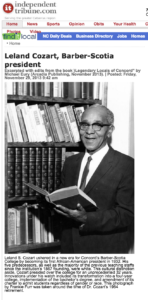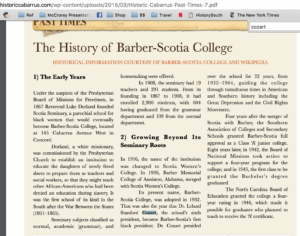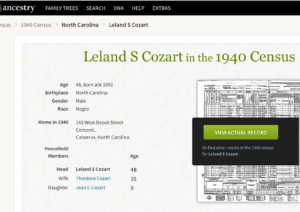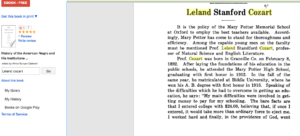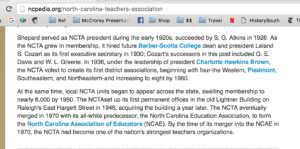1015 Clifton Avenue
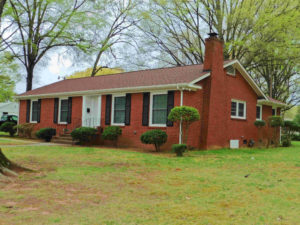 Built in 1959, this was the home of distinguished educator Leland S. Cozart during the last two decades of his life. He served as the first black president (1932 – 1964) of Barber-Scotia College in Concord, North Carolina, the South’s leading Presbyterian college for African American women.
Built in 1959, this was the home of distinguished educator Leland S. Cozart during the last two decades of his life. He served as the first black president (1932 – 1964) of Barber-Scotia College in Concord, North Carolina, the South’s leading Presbyterian college for African American women.
* * *
Leland Stanford Cozart (2.8.1892 – 10.27.1979) came from a family that valued learning. That may be why they named him for Leland Stanford, founder of Stanford University in 1885 and a railroad tycoon who had earlier built America’s Transcontinental Railroad. Leland S. Cozart was born in 1892 in rural Granville County in eastern North Carolina. His family sent him to the Mary Potter School in nearby Oxford, N.C., to complete his high school training. The Mary Potter School was one of a network of private academies created by black Presbyterians to provide high school classes to the “best and brightest” African American youth — something often unavailable in the public schools of the rural South in the era of segregation.
After graduating at the top of his high school class, he went on to Biddle University (as Johnson C. Smith University was then known) in Charlotte, the flagship black Presbyterian college in the South. He graduated with “first honors” in 1916 and would eventually do graduate study at Columbia University in New York and at Harvard University. But first he plunged into work. He did a brief stint as a reporter and magazine writer, then Mary Potter pulled him back to its campus as Professor of Natural Science and English Literature. His career in education had begun.
The smart young man caught the attention of Arthur Bunyan Caldwell, an Atlanta editor and publisher who was compiling a series of volumes profiling “race leaders,” entitled History of the American Negro and His Institutions. He interviewed Cozart, still in his twenties, for the 1921 edition:
“Speaking of the difficulties which he had to overcome in getting an education, [Cozart] says, ‘My main difficulties were involved in getting money to pay for my schooling. The bare facts are that I entered college with $24.00, believing that, if once I entered, it would take more than ordinary force to eject me. I worked hard and finally, in the providence of God, went through college — and trust that college went through me.'”
As a sergeant major stationed in France during World War I, Cozart seized the opportunity to travel extensively in Europe. He also continued to read widely, Bunyan noted, “along the line of his work: science and English literature, philosophy and sociology.”
That combination of experiences gave Cozart a faith in education and a hope for better race relations. The “best element of the Whites” might yet be inspired to make “strong enough protest to prove its opposition to lynching,” he told Bunyan. “I firmly believe that the best interests of the race in this state and nation may be promoted by justice in the courts and equally before the law.”
After several years at Mary Potter, Cozart was recruited to Raleigh in the mid 1920s to become principal of Washington High School, one of the state’s leading black public institutions. Next he signed on with the statewide black North Carolina Teachers Association as its first paid Executive Secretary in 1929. During his time at the helm he helped launch the long running journal North Carolina Teachers Record. When Cozart stepped down, the noted JCSU professor and Rosenwald Fund administrator Dr. George E. Davis took his place at NCTA. That happened in 1932 because Cozart had been tapped to head JCSU’s sister school, all-female Barber-Scotia College in Concord, North Carolina.
Barber-Scotia had begun in 1867, right after the Civil War, as Scotia Seminary. The Board of Presbyterian Missions for Freedmen envisioned a school that would train women as teachers and community workers for the newly freed race. It was the first institution of its kind in the South. Scotia absorbed Barber Memorial College of Anniston, Alabama, in 1930 and became Barber-Scotia College in 1932 just as Leland Cozart came on board.
President Cozart would guide the institution through three decades of change. JCSU began accepting women as juniors and seniors in 1931, so Cozart initially built Barber-Scotia as a two-year junior college. Many graduates went on to JCSU after completing their first and second year studies. When Johnson C. Smith moved to admit women to its freshman class in 1941, Cozart helped his school re-invent itself as a four-year institution. Then on April 2, 1954 — before the U.S. Supreme Court’s landmark Brown v Board school desegregation decision of May 17, 1954 — Barber-Scotia made the decision to admit students without regard to either race or gender. The first student to be admitted was a white male, though the college remained predominantly African American. Though the years the institution attracted students from all over the South. The campus was designated an Historic District on the U.S. National Register of Historic Places in the 1980s and today the administration building, constructed in 1952, is named Cozart Hall in Leland Cozart’s honor.
President Cozart did not just lead the school, he also led the NAACP chapter in Concord. The National Association for the Advancement of Colored People was considered a radical force by white Southerners and it took courage to be publicly associated with the organization. Cozart encouraged his staff to join the NAACP and at times half of the local chapter’s membership came from Barber-Scotia.
Leland Cozart, his wife Theodora and their daughter Jean lived in Concord for most of his career, but as his 1964 retirement neared, he began looking to Charlotte for a new home. The city’s cultural life, the attractions of Johnson C. Smith University, and the fellowship of other Presbyterian leaders made the fast-growing suburb of McCrorey Heights an attractive destination. Ervin Construction, the city’s leading suburban homebuilder, took out a permit in 1959, probably at Cozart’s behest, to build a new house just off prestigious Oaklawn Avenue. Its architecture reflected Cozart’s spirit, striving for fresh ideas but at the same time projecting a dignity grounded in the past: a modern one-story Ranch style design, but with Colonial trim that gave a calm sense of solidity and tradition.
Leland Cozart remained busy during his two decades in this house. He wrote a history of the institution he had led so long, A Venture of Faith: Barber-Scotia College, 1867-1967, published in 1972 and updated in 1976, and also authored A History of the Association of Colleges and Secondary Schools. When Barber-Scotia installed Dr. Mable P. McLean as its first female president in 1976, the only woman in the U.S. leading a black four-year college, Leland Cozart formally presented her at the inauguration. At home, noted his 1979 funeral program, he “found joy and beauty in gardening,” nurturing the trees that now shade this corner lot in McCrorey Heights.
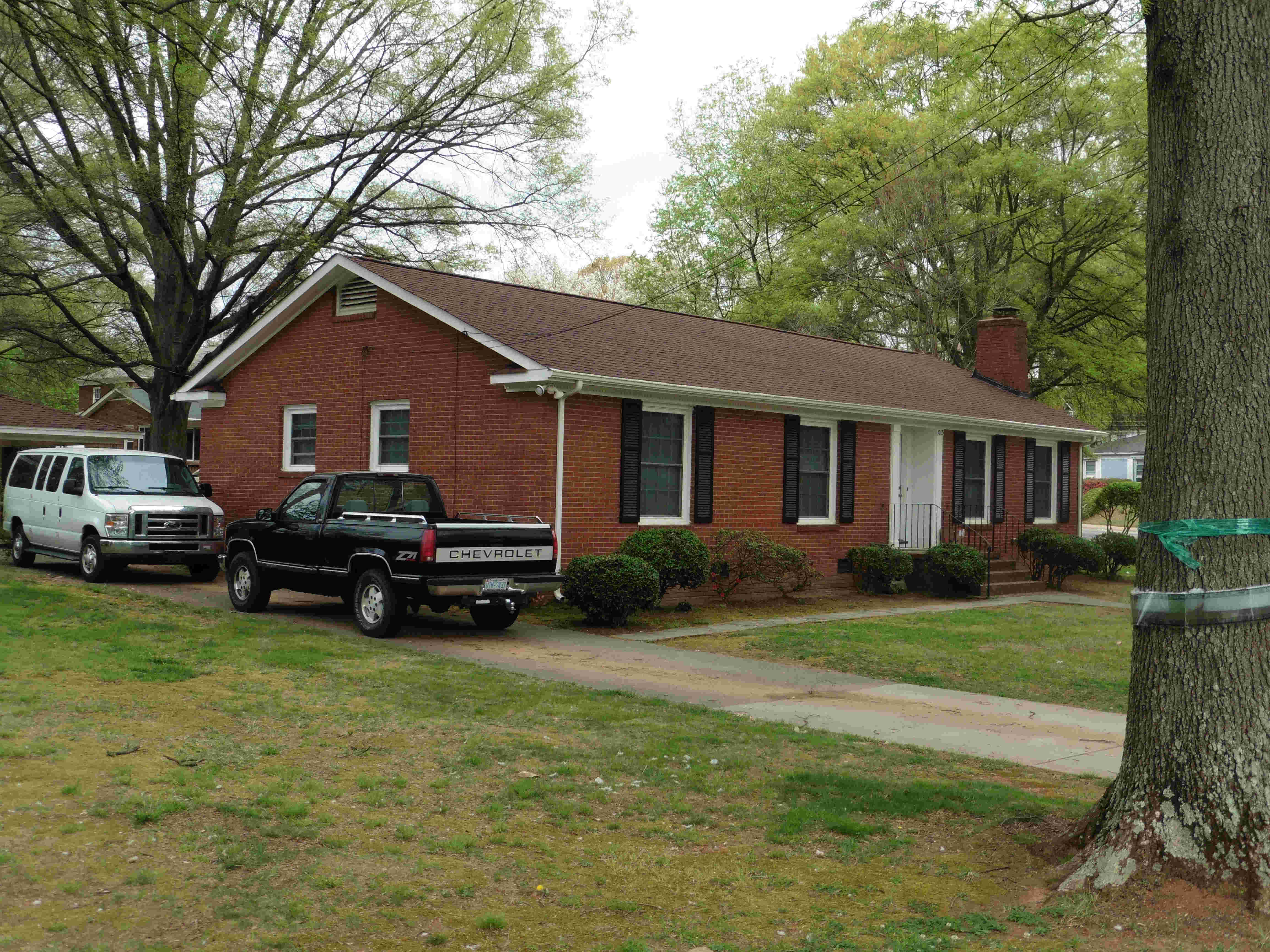
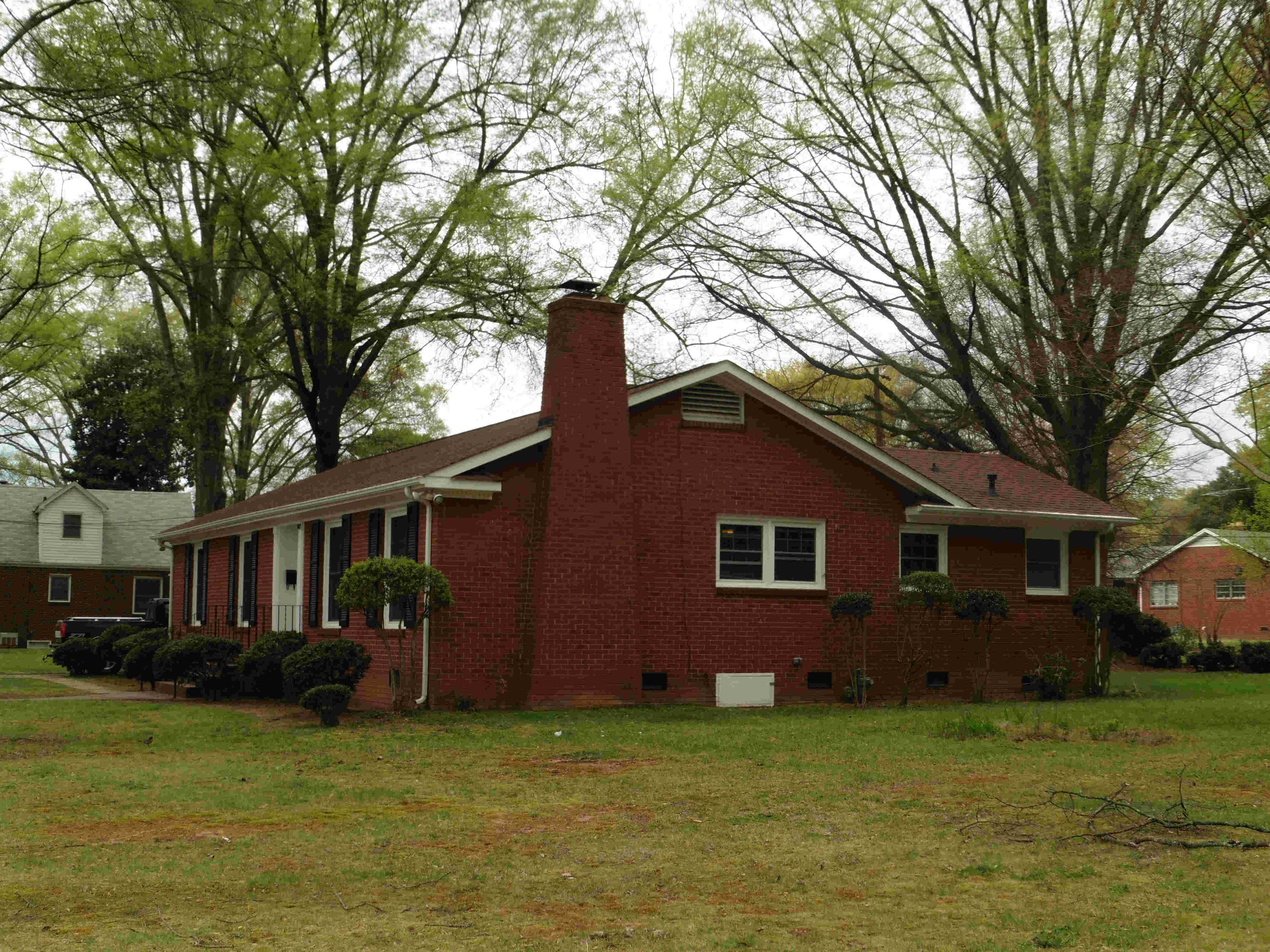
Architecture
One-story red-brick Ranch style house with Colonial touches. The main block of the house has a gable roof and a smaller gable-roofed wing extends to the rear. Under the eaves is a cornice with dentil molding, which extends in the gable ends to form returns — both characteristics of the Colonial Revival. Other Colonial flourishes include: a large slope-shouldered exterior chimney at the south side of the house; tall double-hung front windows with eight-over-eight panes; and an inset front entry with paneled woodwork framed by pilasters. In 1961, soon after moving in to the house, the original owner took out a permit to enclose a back porch and add a free-standing two-vehicle carport at the rear of the property.
The house is one of only a handful in McCrorey Heights that does not face the main avenues of Oaklawn, Washington, Madison, Patton or Van Buren. It fronts on Clifton Avenue on a corner lot with its side facing Oaklawn Avenue.
Building permits
Clifton-1015-permit-a
Date issued: February 2, 1959
Owner: Ervin Construction Co
Contractor: Lauring Electric Co.
Estimated cost:
Other permit info: 70 outlets, 15 fixtures – probably original construction of the house
Clifton-1015-permit
Date issued: September 5, 1961
Owner: L.S. Cozart
Contractor: Wells Construction Co.
Estimated cost: $2,920
Other permit info: Addition, build a carport, close in back porch
First appeared in city directory
1963 – Leland S. Cozart & Theodora P.
He: President, United Presby Church
She: No occupation listed
2000 city directory: Annie E. Bowers
Obituaries
Resources
Cozart, Leland, funeral program in the History Room, First United Presbyterian Church, Charlotte.
“Affiliated Schools, 1920 – 1921,” in Biddle University: General Catalog 1920 – 1921.
“Barber-Scotia College: In the Beginning, Faith,” Past Times: The Newsmagazine of Historic Cabarrus Association, June 2011.
“Barber-Scotia Inaugurates Woman President,” Pittsburgh Courier, April 3, 1976.
Cozart, Leland S., A Venture of Faith: Barber-Scotia College, 1867-1967 (Heritage Printers, 1976)).
“Cozart Hall,” on the Council of Independent Colleges: Historic Campus Architecture Project website.
Justesen, Benjamin R., “North Carolina Teachers Association,” on the NCpedia website.
“Leland Stanford Cozart,” in Arthur Bunyan Caldwell, editor, History of the American Negro and His Institutions, volume 4 (A.B. Caldwell Publishing, 1921)
Newkirk, Vann R., “The Development of the National Association for the Advancement of Colored People in Metropolitan Charlotte, North Carolina, 1919 – 1965 (History Ph.D. dissertation, Howard University, 2002),
Palmer, Elliott B., NCTA Past, Present and Future (Hammocks Beach Corporation, 1970).
Shipp, Julian, “Historically Black Presbyterian Colleges Struggle for Survival,” March 5, 1997. On the Worldwide Faith News Archives website.
